Contemporary Church History Quarterly
Volume 20, Number 1 (March 2014)
Article Note: Nicholas Railton, “Escaping from Sodom: A Christian Jew Encounters German Antisemitism,” Journal of Ecclesiastical History 64 (2013): 787-826.
By Kevin P. Spicer, C.S.C., Stonehill College
In his fascinating article, Nicholas Railton of the University of Ulster’s faculty of arts details the life of Maly Kagan (1897-1963), a Christian of Jewish heritage, to highlight the struggles faced by such individuals under National Socialism. The daughter of Russian immigrants who fled to Germany in the Kaiserzeit, Kagan left Orthodox Judaism in 1919, following a period of spiritual trial and personal tragedy. In 1925, her faith-journey led her to accept a position as an auxiliary nurse at the Innere Mission sponsored Tannenhof psychiatric hospital in Remscheid-Lüttringhausen in the Rhineland. Like many similar institutions in Germany, the Tannenhof hospital underwent nazification within a few months of Hitler’s assumption of power. Steps in this process included the introduction of the Hitler salute for all employees and the implementation of the July 1933 sterilization law. Tannenhof’s clerical director, Pastor Paul Ernst Werner, a devout Nazi and member of the German Christians, zealously promoted National Socialist doctrine through his leadership and bible study sessions. In particular, he was aided by Martha Rielandt, a teacher at Tannenhof and a member of the National Socialist Women’s League, who similarly promoted National Socialist ideology, especially in her classes for trainee deaconesses. Such changes in the institution did not go smoothly, especially after the German Christian Berlin Sportspalast November 1933 fiasco in which Reinhold Krause called for the removal of the Old Testament from the biblical canon. Though evidence is conflicting, it appears that Hildegard von Bülow, Mother Superior of Tannenhof’s deaconesses, challenged Werner and Rielandt on the content of their teaching. Both Werner and Rielandt were eventually removed from their positions. Kagan was also dismissed at the same time. It is unclear if the departures were linked, though Railton surmises that Kagan “became the sacrificial lamb that was meant to limit the influence and impact of Nazi ideology on the establishment” (p. 801).
After finding refugee at the Malche Bible House in Freienwalde an der Oder, upon recommendation of a director there, Kagan made her way to Berlin to begin work with the Hebrew Christian Testimony to Israel (HCTI), a missionary society designed to “bear witness for Christ to the Jewish people in all its lands of their dispersion” (p. 804). There she worked with Heinrich Poms, also a Christian of Jewish heritage, who shared a background similar to Kagan. Following Kristallnacht, Poms and his family fled Germany with Kagan’s assistance. Kagan herself remained behind and assumed the running of the HCTI. Amazingly, she avoided deportation three times and continued in her administrative position. During this time, Kagan was even able to have surgery to correct a degenerate eye condition. She also became involved with relief efforts in connection with Pastor Heinrich Grüber’s Office, the Kirchliche Hilfsstelle für evangelische Nichatarier. This perilous work eventually brought her to hide both Jews and Christians of Jewish heritage in the HCTI building. At some point, the situation became too dangerous for Kagan to remain in public view and she went into hiding until the war ended.
In post-war Germany, the situation for Christians of Jewish heritage within the German Lutheran Church did not change. Railton attributes this to the Church’s unwillingness to address its National Socialist past directly and honestly. He writes: “It was a strange time when silence veiled a multitude of sins committed during the dark night of National Socialism: sins of commission and even more sins of omission” (p. 813). Despite this situation, Kagan resumed her missionary efforts and promoted the healing of wounds between Christians and Jews. To this end, she encouraged her former colleague, Heinrich Poms, to return to Germany to assist her in her efforts. Poms accepted her invitation and inaugurated a series of lectures that addressed the “‘demonic origin of antisemitism’ and the need to repent of all forms of such prejudice” (p. 816). After seven years of toiling with reconciliation work and finding little support from the Lutheran Church, Kagan had had enough. Family members in Israel had already been encouraging her to move there. Giving up on Germany, she accepted their invitation and moved to Israel just outside of Haifa. After her move, she continued to minister to the small Messianic Jewish community there until her sudden death in May 1963, the result of being hit by a motorbike.
Railton’s article informatively relates the horrendous impact of antisemitism on Christians of Jewish heritage. As Railton notes, this is a topic that deserves more scholarly attention. The article is well researched as Railton has thoroughly scoured the existing archives to tell Kagan’s story. Yet, there are some areas where the reader desires more information or greater clarification. For example, this reader would like to know more about the trials Poms and Kagan faced together. Similarly, one learns little about Kagan’s experience in hiding in the last years of the war. More specific examples might also have been offered to illustrate the prolongation of antisemitism in post-war German Lutheranism. These points aside, Railton’s article provides us with a unique insight into the life of one woman who courageously resisted the Nazis by living out her faith conviction. Hopefully, Railton’s work will inspire fellow historians to investigate this under-studied area further.

